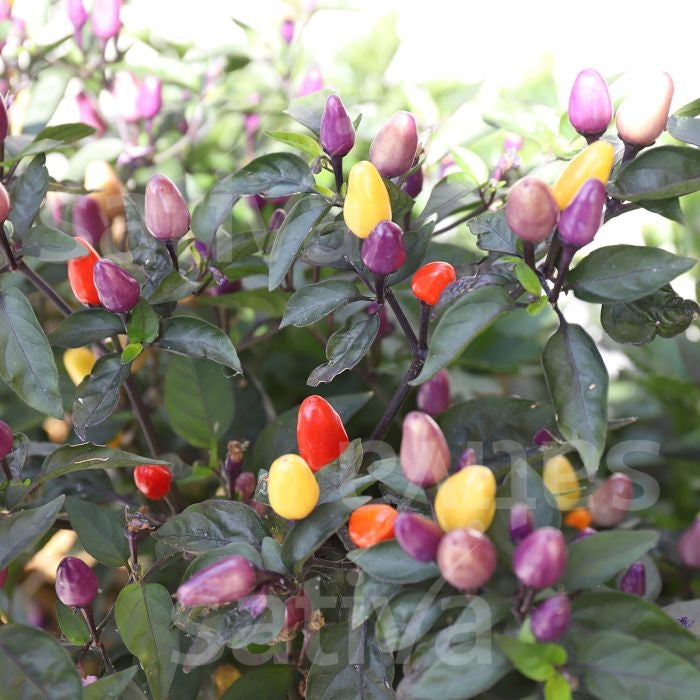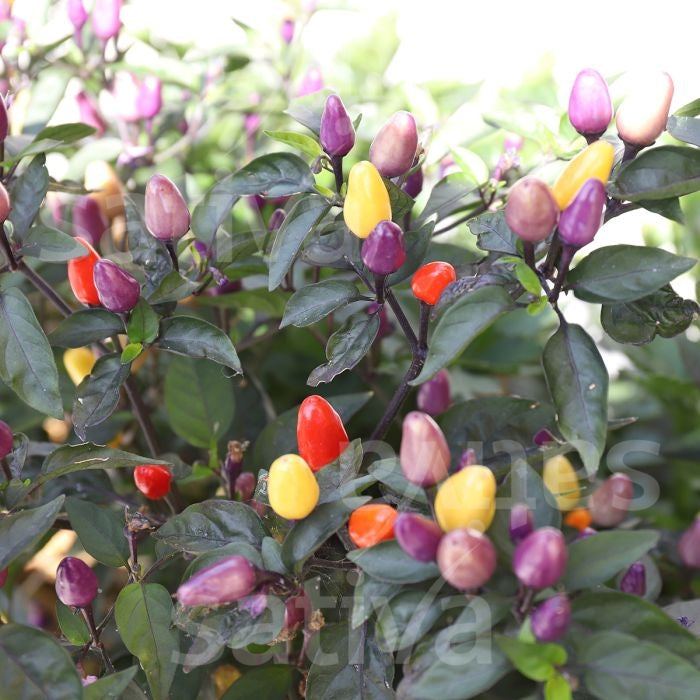LILA LUZI CHILI PEPPER - pa40
Have a question?

LILA LUZI CHILI PEPPER - pa40
Dettagli
Scientific name: Capsicum annum L.
Family: Solanaceae
Brief history and botanical notes on the plant
The pepper, Capsicum annum L. is a plant belonging to the Solanaceae family and is native to the warm countries of South America, where it has a perennial life cycle. In the Mediterranean climate, however, it has an annual cycle.
The hot chili pepper was cultivated in Mexico as early as 5500 BC. It arrived in Europe thanks to Christopher Columbus who brought it from the Americas. Introduced by the Spanish, it acclimatized very well in the old continent, spreading throughout the southern regions, in Africa and Asia, as a cheap alternative spice to cinnamon and nutmeg.
The name pepper derives from the similarity in taste with pepper, Piper in Latin, although the original name by which it was called in the new world was chilli.
The plant generally grown for consumption in its fresh state is a 40 to 80 cm tall bush with light green leaves. The flowers have a white corolla which bears 5 to 7 petals with pale yellow stamens. The other species have different shapes, in the shape of a shrub, with high growth, up to 2 meters in the countries of origin. Capsicum pubescens has purple flowers and black seeds, Capsicum baccatum has specks on the corolla, Capsicum chinense has a white corolla. or greenish and purple stamens, with 2 or more flowers per node. Capsicum frutescens also has a greenish corolla and purple stamens, but the flowers are single.

Needs
The "classic" pepper, given its origins, is very demanding from a thermal point of view: the ideal night temperature is 16-18°C and 24-26°C during the day. Below 15°C the growth of the plant is reduced and stops completely starting from a temperature of 10°C. Resistance to cold and hot climates varies greatly depending on the variety: tabasco (C. frutescens) and rocoto (C. pubescens), for example, also resist -5 C° for short periods. There are also very different light requirements: for the plant grown for consumption in the fresh state in low light conditions there is a reduction in the emission of flowers and in the fertility of the pollen, while the habanero (C. chinense) is very sensitive to sunlight: if excessive it causes sunburn on the fruits.
Sowing and transplanting times
It is sown in February in a heated container and when the second pair of true leaves appear, the seedlings can be re-sprung into individual containers also in a heated container.
Planting is done in March in warmer countries or in late spring (late April, early May), when strong drops in temperature are no longer to be feared, placing the seedlings at 40-60 cm in rows 60-90 cm apart .
Processing
The soil must be very deep, even if it is a plant with an underdeveloped root system, loose, acidic, well drained, rich and with a good sandy component.
Fertilization
It is a very demanding plant in terms of availability of organic substance. However, nitrogen nutrition must not be excessive, to avoid increasing susceptibility to numerous pathogens. To have good ripening and sweet fruit, the availability of potassium is important.
Products
In addition to the pepper, consumed both cooked and raw, the genus includes various species of hot peppers (paprika), ornamental and sweet peppers that can be dried and ground.
To fully exploit their properties, peppers should be consumed immediately after harvesting, but they can also be preserved in oil or powdered (after drying them in the sun), or frozen.
Cultural care
To control wild herbs, mulching with plant materials, biodegradable or plastic films or earthing and weeding interventions can be used, especially in clayey soils.
It is necessary to provide support structures to keep the pepper plant in an upright position to avoid breaking the branches and to have healthy, intact fruit. You can use individual stakes and ties or pull galvanized wires or strings to the sides of the plants supported at the head of the row with poles.
Irrigation
Having a poorly developed root system and a long growth phase, the pepper requires constant good water availability.
Chili pepper also needs a lot of water during cultivation, without however creating stagnation. To increase the spicy taste of the fruits, simply reduce or suspend watering in the days immediately preceding harvesting.
To limit leaf wetting and the development of root system diseases, localized drip or hose irrigation systems are advisable.
Adversity
Among the fungal diseases we remember gray mold, Bacteriosis (Xanthomonas, Pecto bacterium), pedal gangrene (Phytoptora capsici) and tracheomycosis caused by Fusarium oxysporum, Verticillium albo-atrum and Verticillium dahliae, Phytium.
The most important animal parasites are the corn borer (Ostrinia nubilalis), the whitefly (Trialeurodes vaporariorum), the nightfly (Agrotis ipsilon), the American leafminer (Liriomyza trifolii), the root-knot nematodes (Meloidogyne incognita) and some aphids, in particular Macrosiphum euphorbiae.
Diseases caused by abiotic factors: also pay attention to physiopathologies, such as apical rot, caused by water imbalances, and rot and dry areas, caused by sunburn.
Defense products
Important prerequisites are the appropriate choice of cultivation medium, rotations, balanced fertilization, the destruction of plant residues and the choice of seed coming from healthy fruiting plants, as it is a vector of pathogens of all forms.
gray mold: avoid excess water and excessive nitrogen fertilization. Intervene with horsetail decoction and bentonite as well as a discreet side effect of copper-based products
Bacteriosis (Xanthomonas, Pecto bacterium): copper-based products, horsetail decoction
pedal gangrene (Phytoptora capsici): copper-based products after sowing or in post-emergence
tracheomycosis caused by Fusarium oxysporum, Verticillium albo-atrum and Verticillium dahliae: act preventively with the prescriptions indicated previously
Phytium: act preventively with the prescriptions indicated previously
Corn borer (Ostrinia nubilalis): avoid crop rotations between susceptible crops, intervene with Bacillus thuringiensis, use anti-insect netting
whitefly (Trialeurodes vaporariorum): launching of auxiliaries and Neem oil
Root-knot nematodes (Meloidogyne incognita): use intercrops and green manure crops containing nematocidal essences, in particular Brassicaceae (Brassica Juncea, Indian mustard) with a fumigant action.
aphids (Macrosiphum euphorbiae): neem oil. In case of strong attacks, use pyrethrum.
Diseases caused by abiotic factors: manage irrigation and shading.
Production and collection
The collection is scalar. the average production of a plant is around 4-5 kg, in a greenhouse 6-7 kg.
Nutritional values
Peppers, like most vegetables, have a very high water content (over 90%), carbohydrates vary between 2.2 and 4.7g per 100g (with an average of 3.5g) and are composed mainly from glucose and fructose; sucrose is present only in small traces. Vegetable proteins represent approximately 0.7-1.9% of the total (on average 1.1g per 100g). Lipids (or fats) do not exceed 0.2-0.4g per 100g. The energy intake of pepper is modest (about 21 kcal per 100g). Contains 2g of fiber per 100g (mainly pectins, cellulose and hemicellulose).
One of the main nutritional characteristics of pepper is the Vitamin C content (about 126 mg per 100g). also important is the content of Provitamin A (Carotene: 0.7 mg per 100g, in particular red peppers) and minerals and trace elements: potassium in large quantities (over 170 mg per 100g), phosphorus, magnesium and calcium, iron ( 0.4 mg per 100g), copper, manganese and zinc.
The molecule that causes the spiciness is mainly the alkaloid capsaicin, along with other capsaicinoids, each with a different spiciness and flavor. A variation in their proportions determines the different sensations from the different varieties.
These compounds together with some flavonoids have an antibacterial effect, which gives foods cooked with chilli pepper the possibility of being preserved for a long time.
Thanks to the high content of Vitamin C and Provitamin A, two antioxidant vitamins, peppers bring notable beneficial effects on health, protection and prevention of various pathologies: premature aging, tumors and cardiovascular diseases. Furthermore, capsaicinoids are useful in the treatment of colds such as colds, sinusitis and bronchitis, and in promoting digestion. Finally, by stimulating intestinal peristalsis, they promote transit and evacuation.
Several studies have paid particular attention to the potential anti-tumor effects of peppers. Pepper extracts have inhibited the formation or action of some carcinogenic compounds (such as nitrosamines), reducing the risk of contracting brain tumors.
Lastly, despite being appreciated since ancient times for its aphrodisiac properties, there are no studies that demonstrate them.
Family and variety
The classification of pepper varieties, including chili peppers, present especially in South America, is very complex. Limiting ourselves to the cultivars of national interest, they can be distinguished by the particularities of the fruit: flavor (sweet or spicy), shape (small or large in volume, cuboid, more or less regular conical, pyramidal, elongated or short) and color (red , yellow, green, brown or dark).
Among the peppers for consumption in the fresh state we remember:
– the sweet ones with a quadrangular shape (Yellow San Valentino, Yellow sweet square of Nocera, Red square of Asti, Yellow square of Asti, Golden yellow Ercole, Red Ercole, Red sweet square of Nocera), elongated shape (Lungo of Chiasso, Lungo Marconi, Bull's horn, Elephant's trunk, Toro di Spagna), with a pointed shape (Cigarette, Lungo del Veneto, Spagnolino sweet) and with a truncated shape (Small square of Veneto, Parigino, Pimento).
– the spicy ones: long thin chili pepper from Cayenne, Lungo common red, Piccolo di Firenze.
Given the susceptibility to various pathologies, when choosing varietals it is important to favor those with good genetic resistance.
Biodynamics
In addition to the spraying of spray preparations at the plant and in production, the supply of organic substance appropriately composted via biodynamic heap allows us to avoid imbalances in growth and the consequent attacks by parasites.
It is advisable to weed the propagation material with clayey soil mixed with cornoletame 500 or with diluted biodynamic log paste.
The adoption of green manures containing buckwheat and comfrey-based macerates (Symphytum officinalis) favors good ripening and sweetness.
Using the Biodynamic Calendar:
To preserve quality and shelf life, harvest in the morning in the cool hours, possibly on fruit days.


